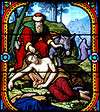Good Shepherd
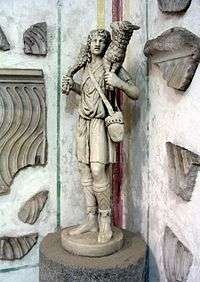
The Good Shepherd (Greek: ποιμήν ο καλός, poimḗn o kalós) is an image used in the pericope of John 10:1-21, in which Jesus Christ is depicted as the Good Shepherd who lays down his life for the sheep. Similar imagery is used in Psalm 23. The Good Shepherd is also discussed in the other gospels, the Epistle to the Hebrews, the First Epistle of Peter and the Book of Revelation in references to Jesus not letting himself lose any of his sheep.
Biblical references
In the Gospel of John, Jesus states "I am the good shepherd" in two verses, John 10:11 and 10:14.
From John 10:11-18 (WEB):
I am the good shepherd. The good shepherd lays down his life for the sheep. He who is a hired hand, and not a shepherd, who doesn't own the sheep, sees the wolf coming, leaves the sheep, and flees. The wolf snatches the sheep, and scatters them. The hired hand flees because he is a hired hand, and doesn't care for the sheep. I am the good shepherd. I know my own, and I'm known by my own; even as the Father knows me, and I know the Father. I lay down my life for the sheep. I have other sheep, which are not of this fold. I must bring them also, and they will hear my voice. They will become one flock with one shepherd. Therefore the Father loves me, because I lay down my life, that I may take it again. No one takes it away from me, but I lay it down by myself. I have power to lay it down, and I have power to take it again. I received this commandment from my Father.
This passage is one of several sections of John's Gospel which generate division among the Jews:
- "There was a division again among the Jews because of these sayings. Many of them said, 'He has a demon and is mad. Why do you listen to Him?' Others said, 'These are not the words of one who has a demon'. (John 10:19-21)
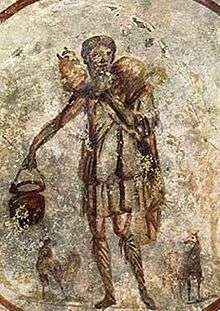
Jesus Christ is also compared to a shepherd in Matthew 2:6, Matthew 9:36, Matthew 25:32, Matthew 26:31, Mark 6:34, Mark 14:27, John 10:2, Hebrews 13:20, 1 Peter 2:25, 1 Peter 5:4, and Revelation 7:17.
Parable or metaphor?
Several authors such as Barbara Reid, Arland Hultgren or Donald Griggs comment that "parables are noticeably absent from the Gospel of John".[2][3][4] According to the Catholic Encyclopedia article on Parables:[5] "There are no parables in St. John's Gospel" and according to the Encyclopædia Britannica article on Gospel of St. John:[6] "Here Jesus' teaching contains no parables and but three allegories, the Synoptists present it as parabolic through and through." These sources all suggest that the passage is better described as a metaphor than a parable.
Early Christian art
The image of the Good Shepherd is the most common of the symbolic representations of Christ found in Early Christian art in the Catacombs of Rome, before Christian imagery could be made explicit. The form of the image showing a young man carrying a lamb round his neck was directly borrowed from the much older pagan kriophoros (see below) and in the case of portable statuettes like the most famous one now in the Pio Cristiano Museum, Vatican City (right), it is impossible to say whether the image was originally created with the intention of having a Christian significance. The image continued to be used in the centuries after Christianity was legalized in 313. Initially it was probably not understood as a portrait of Jesus, but a symbol like others used in Early Christian art,[7] and in some cases may also have represented the Shepherd of Hermas, a popular Christian literary work of the 2nd century.[8][9] However, by about the 5th century, the figure more often took on the appearance of the conventional depiction of Christ, as it had developed by this time, and was given a halo and rich robes,[10] as on the apse mosaic in the church of Santi Cosma e Damiano in Rome, or at Ravenna (right). Images of the Good Shepherd often include a sheep on his shoulders, as in the Lukan version of the Parable of the Lost Sheep.[11]
See also
- Depictions of Jesus
- I am (biblical term)
- Names and titles of Jesus in the New Testament
- Parable of the Lost Sheep
- The Sheep and Goats
- Mausoleum of Galla Placidia
Gallery
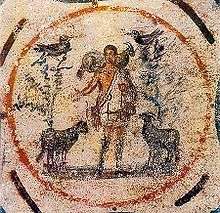 At the Catacomb of Priscilla, Rome
At the Catacomb of Priscilla, Rome- Fourth century depiction at the Museum of the Baths of Diocletian, Rome
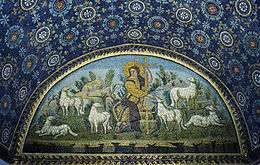 Mosaic in the Mausoleum of Galla Placidia, Ravenna, Italy, ca. 425
Mosaic in the Mausoleum of Galla Placidia, Ravenna, Italy, ca. 425- Christ as the Good Shepherd, unknown artist from Lower Bavaria, 1750
 19th century by German Artist Bernard Plockhorst
19th century by German Artist Bernard Plockhorst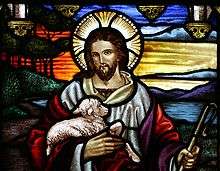 20th century stained glass depiction, Australia
20th century stained glass depiction, Australia
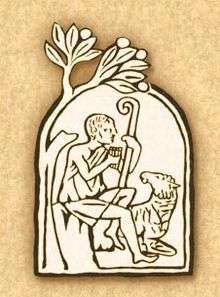
References
| Wikimedia Commons has media related to Good Shepherd. |
- ↑ "The figure (...) is an allegory of Christ as the shepherd" Andre Grabard, "Christian iconography, a study of its origins", ISBN 0-691-01830-8
- ↑ Barbara Reid, 2001 Parables for Preachers ISBN 0-8146-2550-9 page 3
- ↑ Arland J. Hultgren, 2002 The Parables of Jesus ISBN 0-8028-6077-X page 2
- ↑ Donald L. Griggs, 2003 The Bible from scratch ISBN 0-664-22577-2 page 52
- ↑ "CATHOLIC ENCYCLOPEDIA: Parables".
- ↑ http://www.1911encyclopedia.org/Gospel_Of_St_John
- ↑ Eduard Syndicus; Early Christian Art; pp. 21-3, Burns & Oates, London, 1962
- ↑ The Two Faces of Jesus by Robin M. Jensen, Bible Review, 17.8, October 2002
- ↑ Understanding Early Christian Art by Robin M. Jensen, Routledge, 2000
- ↑ Syndicus, 130-131
- ↑ Lowrie, Walter (1947). [https://books.google.com/books?id=0fwCGTzbMQ0C&pg=PA69 Art in the Early Church] Check
|url=value (help). Pantheon Books. p. 69. ISBN 1-4067-5291-6.
External links
- Holman Bible Dictionary - "Shepherd" for other Biblical references.
- Online IMAGE Collection of the Good Shepherd.
